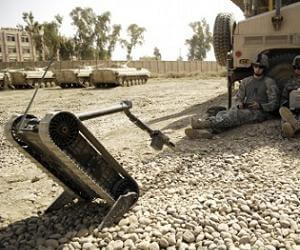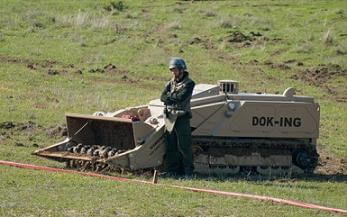2000+ Robots in US Ground Forces in Afghanistan

Share
For every 50 US soldiers in Afghanistan, we have about 1 robot, but those numbers are getting better every year. From 2009 to 2010, 1400 terrestrial bots were sent to Afghanistan according to Lt. Col. Dave Thompson who spoke at the Association for Unmanned Vehicle Systems International program review earlier this month. The Marine Corps Colonel stated that about one third of these robots weren't used for the explosive ordnance disposal (EOD) missions that such ground bots have become famous for. Instead, soldiers are increasingly employing these systems for reconnaissance and surveillance. That's led to a sharp rise in demand. The US Army wants more robots, and companies like Qinetiq, iRobot, and DOK-ING are going to provide them. I think this trend is only going to continue until robots of one form or another represent a majority on the battlefield.
During the recent wars in Iraq and Afghanistan, the US has become increasingly reliant on robots in EOD missions. Devices like iRobot's Packbot or Qinetiq's Talon are capable of approaching suspicious packages and helping to detonate them while soldiers can remain at a (relatively) safe distance. The prevalence of improvised explosive devices (IEDs) has been a center piece to these wars, and the importance of EOD has grown accordingly. We've seen an Academy Award winning film (The Hurt Locker) focus on the tragedy and stress associated with EOD duty, but the US Army presents a different take on the subject. Their pitch: EOD is cool because you get to play with robots. Check out the following video to see what I mean.
According to Lt. Col. Thompson, who is project manager at the Robotics Systems Joint Project Office, it looks like more and more soldiers are learning what EOD teams already know: whether you think they're cool or just a necessity, robots save soldier lives. According to National Defense Magazine, robots are being used at entry points to help visually scan vehicles for explosive packages. At the AUVSI program review, Thompson mentioned that new tactics are arising around using bots in non-EOD missions, but he couldn't comment on their nature because they were classified. I imagine that a ground robot, even if slow and unable to scale obstacles, could be a valuable asset when you want to find enemy combatants lurking in ambush. In the following video, engineers at the Joint Readiness Training Center are experimenting with some (not too practical) possible applications for groundbots. Most of this looks to be just for fun, but you can see how soldiers are both comfortable and creative with their robotic counterparts.
Warning: the following clip contains language not suitable for some viewers:
Be Part of the Future
Sign up to receive top stories about groundbreaking technologies and visionary thinkers from SingularityHub.


The range of these devices suggest that robots are finding niche uses in many areas of warfare. Small wheeled systems like the Packbot or Talon can be carried easily in the back of a truck, and deployed quickly in hostile environments. Larger units, like the M160 (MV-4), can be used to remotely sweep fields for mines or even act as a target to trigger IEDs ahead of manned vehicles. Alongside these robotic ground forces are armed flying drones like the Predator and Reaper we've discussed before. Adding in RC surveillance drones and automated turrets brings up the count for military 'robots' in the Middle East even further. In every case, these systems are either actively replacing the soldier in a dangerous situation or helping them survive by augmenting their abilities.
If you were a soldier in these wars, wouldn't you be clamoring for these devices as well?
There are dangers associated with automating any part of the military, but the drive to save the lives of US soldiers is overwhelming, and I think it's going to continue to push us towards increasing the presence of robots. We've already seen how combat capable jet fighters are being herded towards use in the Navy, and armed ground robots have been around for years. How long until we trust these devices (either with remote control or autonomous functions) to handle armed combat? How long after that until we prefer to use them in the field rather than send human soldiers?
Ground based units may continue to be relegated to EOD-type duties for the foreseeable future, but military robots as a whole are taking larger roles in combat through the use of remotely controlled or semi-autonomous flying drones. The US has already started the march towards an automated army. 2000+ bots in Afghanistan seems like a lot now, but that's only about 2% of our ground forces. I think we'll hit 10% before we're out of this conflict (especially as human troops are withdrawn from the region). Eventually, there could be more bots than US soldiers in active war zones. That time is probably a long way off, but it seems closer everyday.
[image credit:iRobot]
[video credit: GoArmyVideos, bs20grt]
[sources: National Defense Magazine, Qinetiq, DOK-ING, iRobot]
Related Articles

These Robots Are the Size of Single Cells and Cost Just a Penny Apiece

In Wild Experiment, Surgeon Uses Robot to Remove Blood Clot in Brain 4,000 Miles Away

A Squishy New Robotic ‘Eye’ Automatically Focuses Like Our Own
What we’re reading

